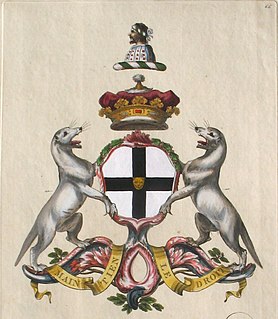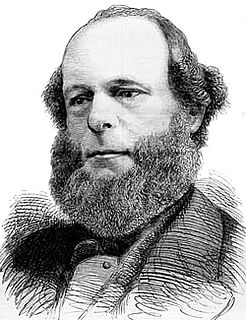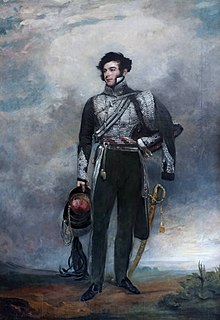Duke of Buckingham held with Duke of Chandos, referring to Buckingham, is a title that has been created several times in the peerages of England, Great Britain, and the United Kingdom. There have also been earls and marquesses of Buckingham.

Richard Temple-Nugent-Brydges-Chandos-Grenville, 1st Duke of Buckingham and Chandos, styled Earl Temple from 1784 to 1813 and known as the Marquess of Buckingham from 1813 to 1822, was a British landowner and politician.

Baron Lyttelton is a title that has been created one in Peerage of England and twice in Peerage of Great Britain, both times for members of the Lyttelton family. Since 1889 the title has been a subsidiary title of the viscountcy of Cobham.

Viscount Cobham is a title in the Peerage of Great Britain that was created in 1718. Owing to its special remainder, the title has passed through several families. Since 1889, it has been held by members of the Lyttelton family.

Marquess of Ailesbury, in the County of Buckingham, is a title in the Peerage of the United Kingdom. It was created on 17 July 1821 for Charles Brudenell-Bruce, 2nd Earl of Ailesbury.

Earl of Cardigan is a title in the Peerage of England, currently held by the Marquesses of Ailesbury, and used as a courtesy title by the heir apparent to that Marquessate, currently David Brudenell-Bruce, Earl of Cardigan, son of the 8th Marquess. The Brudenell family descends from Sir Robert Brudenell, Chief Justice of the Common Pleas from 1520 to 1530. His great-grandson, Sir Thomas Brudenell, was created a Baronet in the Baronetage of England, styled "of Deene in the County of Northampton", on 29 June 1611. On 26 February 1628, he was raised to the Peerage of England as Baron Brudenell, of Stanton Wyvill in the County of Leicester, and on 20 April 1661 he was further honoured when he was made Earl of Cardigan, also in the Peerage of England. On his death, the titles passed to his son, Robert, the 2nd Earl, and on the 2nd Earl's death to his grandson, George, the 3rd Earl, the 2nd Earl's only son, Francis, Lord Brudenell, having predeceased his father.

Earl of Elgin is a title in the Peerage of Scotland, created in 1633 for Thomas Bruce, 3rd Lord Kinloss. He was later created Baron Bruce, of Whorlton in the County of York, in the Peerage of England on 30 July 1641. The Earl of Elgin is the hereditary Clan Chief of Clan Bruce.

Earl Temple of Stowe, in the County of Buckingham, is a title in the Peerage of the United Kingdom. It was created in 1822 for Richard Temple-Nugent-Brydges-Chandos-Grenville, 2nd Marquess of Buckingham, who was created Marquess of Chandos and Duke of Buckingham and Chandos at the same time. In contrast to the Marquessate and Dukedom, which were created with remainder to the heirs male of his body only, the Earldom was created with remainder to (1) the heirs male of his body, failing which to (2) the heirs male of his deceased great-grandmother the 1st Countess Temple, failing which to (3) his granddaughter Lady Anna Grenville and the heirs male of her body, and then to possible younger daughters of Lord Temple and the heirs male of their bodies.

The Dukedom of Chandos is a title that has been created twice in the Peerage of England. First created as a barony by Edward III in 1337, its second creation in 1554 was due to the Brydges family's service to Mary I during Wyatt's rebellion, when she also gave them Sudeley Castle. The barony was elevated to a dukedom in 1719, and it finally fell into abeyance in 1789, after 452 years.
The Baronetcy of Temple, of Stowe, in the Baronetage of England, was created on 24 September 1611 for Thomas Temple, eldest son of John Temple of Stowe, Buckinghamshire. His great-grandson Sir Richard, 4th Baronet, was created Baron Cobham on 19 October 1714, and Viscount Cobham and Baron Cobham on 23 May 1718, the latter with a special remainder, failing his male issue to his sisters and their heirs male. Upon his death on 13 September 1749, the barony of 1714 became extinct, the viscountcy and barony of 1718 passed to his elder sister, and the baronetcy passed to his second cousin once removed William Temple, of Nash House, who became 5th Baronet. On the death of Sir William's nephew Sir Richard Temple, 7th Baronet, on 15 November 1786, the baronetcy became dormant.

Richard Plantagenet Campbell Temple-Nugent-Brydges-Chandos-Grenville, 3rd Duke of Buckingham and Chandos, styled Earl Temple until 1839 and Marquess of Chandos from 1839 to 1861, was a British soldier, politician and administrator of the 19th century. He was a close friend and subordinate of Benjamin Disraeli and served as the Secretary of State for the Colonies from 1867 to 1868 and Governor of Madras from 1875 to 1880.
Earl Nugent was a title the Peerage of Ireland. It was created on 21 July 1776 for Robert Craggs-Nugent, 1st Viscount Clare, with remainder, failing heirs male of his body, to his son-in-law The 3rd Earl Temple and the heirs male of his body. Craggs-Nugent had already been made Baron Nugent, of Carlanstown in the County of Westmeath, and Viscount Clare, in the Peerage of Ireland on 19 January 1767. He died 13 October 1788, when the barony and viscountcy became extinct, and the earldom, under the terms of the special remainder, passed to his son-in-law, formerly known as Lord Temple, now The 1st Marquess of Buckingham. The earldom remained in his family until the death of The 5th Earl Nugent, also The 3rd Duke of Buckingham and Chandos, on 26 March 1889. See Viscount Cobham for further history of the title. The barony of Nugent was revived in 1800 in favour of his daughter, Mary, Marchioness of Buckingham. See Baron Nugent.

Richard Plantagenet Temple-Nugent-Brydges-Chandos-Grenville, 2nd Duke of Buckingham and Chandos,, styled Viscount Cobham from birth until 1813, Earl Temple between 1813 and 1822 and Marquess of Chandos between 1822 and 1839, was a British Tory politician. He served as Lord Privy Seal between 1841 and 1842.
British history provides several opportunities for alternative claimants to the English and later British Crown to arise, and historical scholars have on occasion traced to present times the heirs of those alternative claims.
James Brydges, 3rd Duke of Chandos PC, styled Viscount Wilton from birth until 1744 and Marquess of Carnarvon from 1744 to 1771, was a British peer and politician.

Charles Bruce, 3rd Earl of Ailesburyand 4th Earl of Elgin, of Ampthill, Bedfordshire and Savernake Park, Wiltshire, styled Viscount Bruce of Ampthill from 1685 to 1741, was a British landowner and Tory politician who sat in the English and British House of Commons from 1705 until 1711 when he was raised to the peerage as one of Harley's Dozen and sat in the House of Lords.
William Bruce, 8th Earl of Kincardine, the son of Thomas Bruce, 7th Earl of Kincardine and Rachel Paunceforth, became the 8th Lord of Torry and the 8th Earl of Kincardine in 1740.
Mary Elizabeth Morgan-Grenville, 11th Lady Kinloss was a British peeress.
Teresa Mary Nugent Freeman-Grenville, 13th Lady Kinloss is a Scottish peer.
Duchess of Buckingham is a title given to the wife of the Duke of Buckingham, an extinct title created several times, formerly in the Peerage of England and latterly in the Peerage of the United Kingdom. It was first created in 1444.











